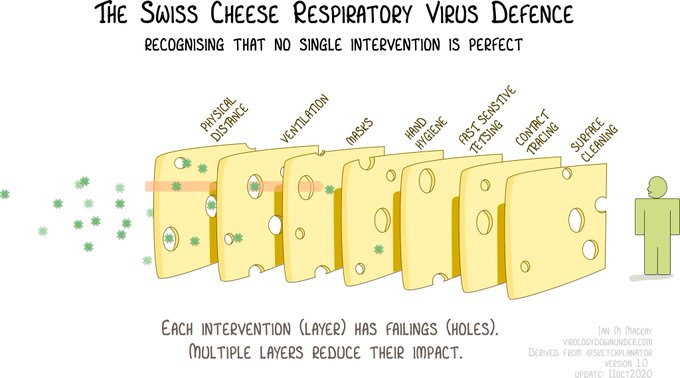Let’s talk about the “Swiss cheese model” of combatting the COVID-19 pandemic. This is a classic conceptualization of how to cope with hazards, and it powerfully illustrates several features of what we are facing in the pandemic. #SwissCheeseModel (Image h/t @MackayIM) 1/
What is required to stop the spread of a pathogen like SARS-CoV-2 is achieving some kind of (minimum) threshold level of response sufficient to achieve a deflection in the trajectory of the epidemic, to bring it under control. 2/
A combination of “contact reduction” interventions (eg, school closures, gathering bans) and “transmission reduction” interventions (eg, handwashing, masking) is required. These are “non-pharmaceutical interventions” (NPI), in contrast to things like medicines and vaccines. 3/
But here is the thing: no matter the specific combination of non-pharmaceutical interventions, so long as a certain *threshold* is achieved, the pandemic can be brought to heel. #SwissCheeseModel 4/
As discussed in Apollo’s Arrow ( https://www.amazon.com/Apollos-Arrow-Profound-Enduring-Coronavirus/dp/0316628212/),">https://www.amazon.com/Apollos-A... any *combination* of responses may be adequate.
But a person, family, firm, or nation must implement at least some interventions, and they must do more than just one or two! #APOLLOSARROW 5/
But a person, family, firm, or nation must implement at least some interventions, and they must do more than just one or two! #APOLLOSARROW 5/
In order to stop the spread of SARS-CoV-2 and substantially reduce the risk of the COVID-19 epidemic in a family, firm, or nation, one just needs enough layers of Swiss cheese (in the #SwissCheeseModel), but not necessarily *all* of them. 6/
This also explains how and why different countries have succeeded -- using different combinations of approaches.
In Korea, they relied on masking and testing; in New Zealand, on border closures and contact tracing; in Greece, on gathering bans and school closures. 7/
In Korea, they relied on masking and testing; in New Zealand, on border closures and contact tracing; in Greece, on gathering bans and school closures. 7/
To be clear, the foregoing countries did more than just those things mentioned. And most countries did various combinations of things. And the timing of implementation is also crucial. 8/
Here are two recent @nature papers assessing the impact of a selection of NPI interventions: https://www.nature.com/articles/s41586-020-2405-7">https://www.nature.com/articles/... & https://www.nature.com/articles/s41586-020-2293-x">https://www.nature.com/articles/...
And also, via @medrxivpreprint, two others: https://www.medrxiv.org/content/medrxiv/early/2020/08/04/2020.08.02.20166793.full.pdf">https://www.medrxiv.org/content/m... & https://www.medrxiv.org/content/medrxiv/early/2020/07/01/2020.06.30.20142877.full.pdf">https://www.medrxiv.org/content/m... 9/
And also, via @medrxivpreprint, two others: https://www.medrxiv.org/content/medrxiv/early/2020/08/04/2020.08.02.20166793.full.pdf">https://www.medrxiv.org/content/m... & https://www.medrxiv.org/content/medrxiv/early/2020/07/01/2020.06.30.20142877.full.pdf">https://www.medrxiv.org/content/m... 9/
This conceptualization also explains why countries and places that do not do enough, that do not have enough layers of Swiss Cheese, wind up with outbreaks. 10/
The recent failure to control COVID-19 in the White House super-spreading event may relate to an over-reliance on testing, without *also* implementing physical distancing, masking, or additional interventions. (For tracking that event as it unfolded: https://twitter.com/NAChristakis/status/1312058167983996929?s=20)">https://twitter.com/NAChrista... 11/
Some "layers" of the Swiss cheese have fewer or smaller holes (are more effective) and are especially helpful when they part of the stack of interventions aimed at stopping SARS-CoV-2 from penetrating the defenses. Being outdoors, testing, and masks are in this category. 12/
This #SwissCheeseModel conceptualization was first introduced by James Reason to discuss failures in complex systems that require coordination of many human and mechanical elements in order to avoid catastrophe (such as in nuclear power and airplane accidents). 13/
A classic application of the #SwissCheeseModel by James Reason to the occurrence of medical error, after the failure of multiple layers of defense, was in this 2000 @bmj_latest paper https://www.bmj.com/content/320/7237/768">https://www.bmj.com/content/3... #socy126 14/

 Read on Twitter
Read on Twitter




